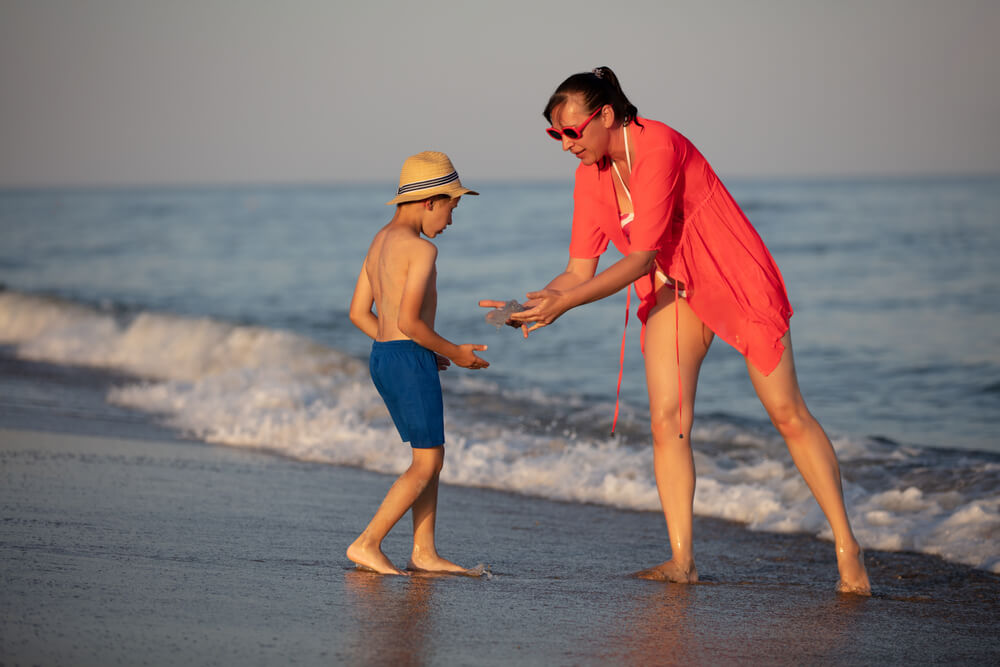How to Stop Bullying in Schools? Protection, Prevention, Facts
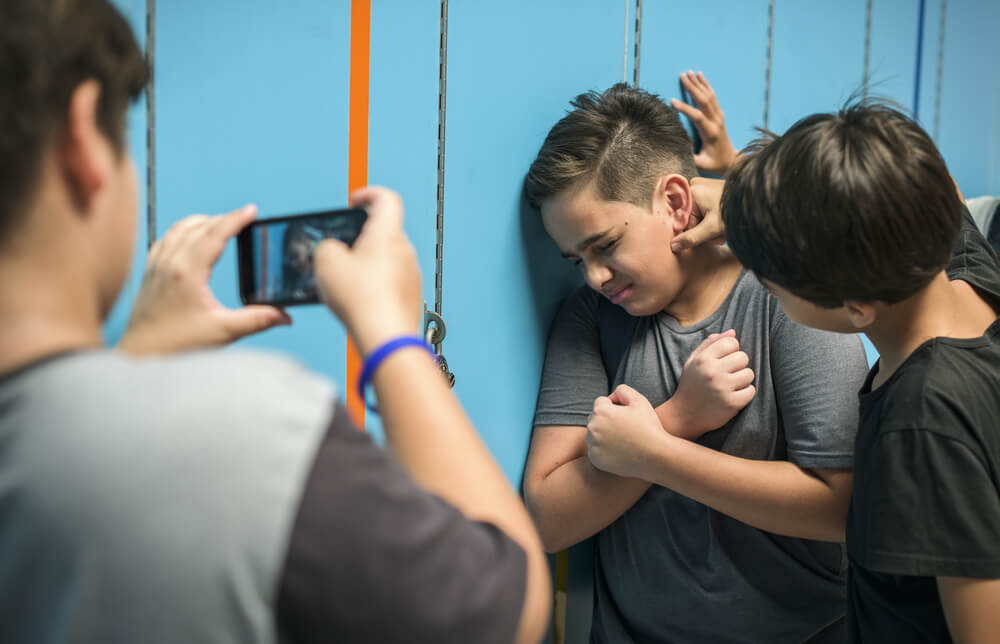
It’s vital for both parents and teachers to stay mindful in the classroom, and watchful for any signs of bullying behavior. Such behavior can be subtle, and build up over time, so nipping it in the bud—and giving kids the tools they need to deal with bullying—is crucial.
This article is about bullying at school. It is about badgering, intimidation, and harassment. According to data, from Unicef half of all students, globally, have experienced peer-to-peer violence in or around the school. Moreover, this figure is rising. More and more frequently we see horrifying headlines in the media: ‘The teenagers posted the video of beating their classmate’ or The girl committed suicide because of the bullying in the school’.
The problem of bullying is a modern and acute social issue. We cannot ignore it—if left unresolved, it can have terrible consequences.
This article is written for all parents, children, and teachers who have faced a challenge like bullying and harassment in school.
Are you worried that your child is being bullied at school? Find out whether bullying is taking place and help your child by using the LIVE-listening function in the Findmykids app by downloading it from the AppStore or Google Play.
Contents:
- Bullying Is a Type of Violence
- Bullying Impact and Consequences
- How to Recognize If Your Child is a Victim of Bullying?
- Findmykids App: Empowering Parents in the Fight Against Bullying
- How to Deal With Bullying at School?
- How to Prevent Bullying in Schools?
- FAQ
Bullying Is a Type of Violence

Prostock-studio/Shutterstock.com
The Concept
The term ‘bullying’ was formulated by a Norwegian psychology professor from the University of Bergen, Dan Olweus. He gave the first definition of the term—’the kind of violence suggesting the aggressive prosecution one of the members of the team’.
Olweu sundertook the first study of bullying among Norwegian and Swedish students. In practice, however, he has realized that 15% of children regularly face bullying in their schools: 9% are victims of bullying, 7% of kids are aggressors, and 2% of students act as both.
⠀
The results of a new modern study of bullying, according to USA research using 2019 data, showed that: 13% of students have suffered from verbal bullying, 12% have been the victim of malicious gossip, 5% of children have faced physical abuse and about 5% felt unwelcome in the classroom in general due to the behavior of their fellow students.
Bullying can occur at any stage of education—in junior and middle school or among high school graduates.
The same phenomenon can exist in teams of adults and may consist of harassment, silent treatment, and whistle-blowing. Researchers found that around 30% of workers in the USA have experienced bullying in the workplace—and about 23% of these victims of bullying resign.
Types of Bullying
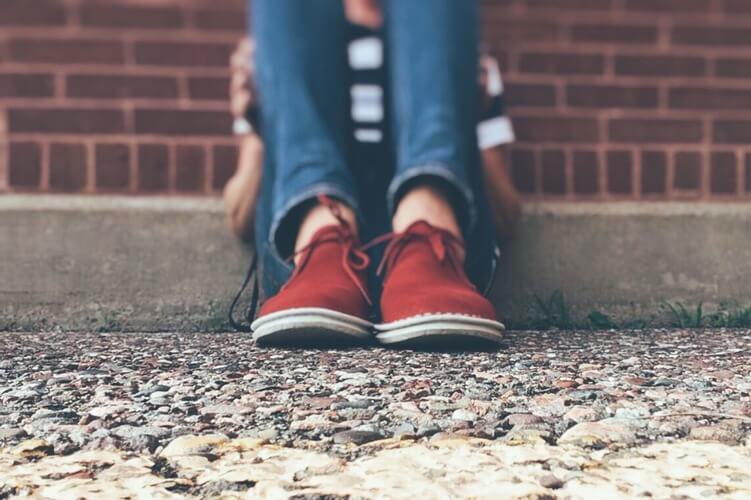
Prostock-studio/Shutterstock.com
What are the different types of bullying:
- Physical—is using one’s body and physical bodily acts to exert power over peers. Punching, kicking and other physical attacks are all types of physical bullying
- Verbal—threats, insults, and mockery
- Social-psychological—this type of bullying leads to exclusion and isolation (malicious gossip, speculation, silent treatment, manipulation)
- Economical—extortion or theft of money, things, spoiling of clothes
- Cyberbullying—bullying that takes place over digital devices like cell phones, computers, and tablets. Cyberbullying includes sending, posting, or sharing negative, harmful, false, or mean content about someone else. It can include sharing personal or private information about someone else causing embarrassment or humiliation. It’s a modern form of bullying that can be very tricky to deal with, as there is no sure way to protect from it
Bullying and suicide, more commonly called ‘bullycide’, is defined as a death by suicide where bullying is the causative factor. The most well-known incident happened in the USA in 2006 when a 13 years old girl, along with her mother, mocked another girl via the social network ‘My Space’. The victim couldn‘t stand the harassment and committed suicide.
Who Participates in Bullying?

Prostock-studio/Shutterstock.com
In bullying usually takes part a victim, an aggressor, and bystanders. They are all participants in bullying.
Victims
No matter what is the cause of bullying. More often as victims act the children:
- With physical disabilities or developmental characteristics (decreased audibility or visibility, VBCs and etc)
- Insecure, reserved, anxious, with low self-esteem and a lack of social skills
- With unusual appearance (freckles, plumpness/thinness and etc)
- With low intellect and studying problems
- Teacher‘s ‘darlings’ or outcasts
The impossibility to confront their bulliers unites them all. They can‘t fight back and protect themselves.
Aggressors

Prostock-studio/Shutterstock.com
A would-be bully is a person:
- With low self-esteem which he or she tries to increase by humiliating others
- Who try to be in the spotlight whatever it takes
- Aggressive, violent, prone to dominance and manipulation
- With family and child-adult problems
As aggressors can be children from dysfunctional families as well as from families with high financial positions.
Bystanders
It is the biggest category of participants in school bullying.
Bystanders are individuals who witness bullying incidents. There are three options of course for the situation. A bystander can stand for a victim, putting his own neck on the line and risking becoming a new victim. Also, he or she can have a passive attitude and not intervene in bullying. And the third way is the supporting of the aggressor and helping him to humiliate others.
The Features of Modern Bullying in Schools
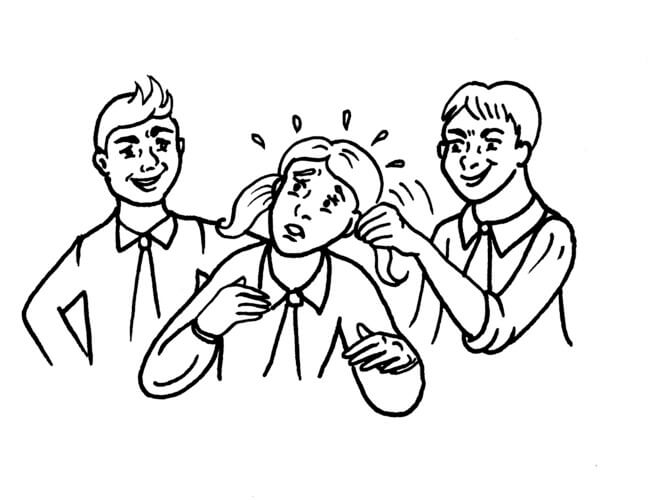
Prostock-studio/Shutterstock.com
First of all, it’s important to remember that, today, bullying often happens in cyberspace, via channels such as social networks and messaging platforms. Users can choose new usernames and text or post comments anonymously. This can cause real problems, as bullies believe that there will be no recourse from their actions: a bully may send aggressive or obscene videos and photos to other users, for example, or text their abusive comments.
One more important fact to bear in mind is that girls nowparticipate in bullying to the same extent as boys. Whereas in past years boys used to make up the majority of aggressors, now the ratio is 50:50. The number of girls taking part in bullying is rising.
Furthermore, teachers can be the victims of bullying at school too. Back in the day, students could maybe put some glue on the teacher‘s chair, but now there are occurrences in which kids insult and humiliate the teacher during the lesson, or even become physically aggressive.
Bullying Impact and Consequences

Prostock-studio/Shutterstock.com
Sometimes, the act of bullying can give an aggressor a sense of self-worth. If their behavior, however, is unchecked, this can have terrible consequences for both the victim and the bully themselves.
Bystanders may feel guilt and shame about feeling unwilling or unable to help.
The most serious psychological trauma, in the majority of cases, is suffered by the victim. Even as adults, victims often remember all the painful experiences connected with childhood bullying.
Psychologists point out that school bullying is comparable with domestic violence, in terms of the severity of the effects.
- A victim may suffer psychosomatic ailments as a result: headaches, sleep, and eating issues, chronic diseases may be exacerbated.
- Depressive disorders, anxiety, specific neurotic disorders.
- The most serious reactions to bullying are attempts to commit suicide or to take matters into their own hands and elicit some form of revenge.
School Shooting as a Result of Bullying
A phenomenon of modern society is school shootings. These tragic incidents are attacks on educational institutions, such as a primary school, secondary school, or university, involving the use of firearms. One of the earliest school shootings occurred in April 1999, in which two students shot 13 people before turning their weapons on themselves.
A more recent tragedy saw a 14-year-old kid shoot and injure 10 children in a playground at Wynbrooke Elementary School.
These accidents are almost uncomprehendingly horrific—and it’s possible that bullying may have played a part.
How to Recognize If Your Child is a Victim of Bullying?

Prostock-studio/Shutterstock.com
Children don‘t share all of their problems with adults. That‘s why parents need to be mindful to recognize the symptoms of bullying in time. The following things may indicate a problem. The child:
- Has a negative view of the school, tries to take every opportunity to miss their classes
- Comes home seeming down or anxious
- Cries often without any reason
- Doesn‘t speak about his/her school life and schoolmates
- Has a poor appetite and isn’t sleeping well
- Regularly has bruises and abrasions on his or her body and face
A child who is being bullied may also lose interest in activities or hobbies they used to enjoy, so look out for this, too. While it’s normal for kids’ interests to change over time, if there’s a sudden or unexpected shift, then this could be a sign that something’s not right. Similarly, if the friends that used to formerly come calling for them start to vanish, or if your child tells you they don’t have any friends at school, this could be a red flag regarding bullying. Try asking your child about their peers or friends, and watch their reaction closely to gain an insight into what’s going on.
A sudden drop in grades could also be a sign of bullying. The distraction and distress that bullying can cause—along with issues such as sleep deprivation and trouble eating—can all cause significant problems that may affect your child’s concentration and ability to academically perform.
Findmykids App: Empowering Parents in the Fight Against Bullying
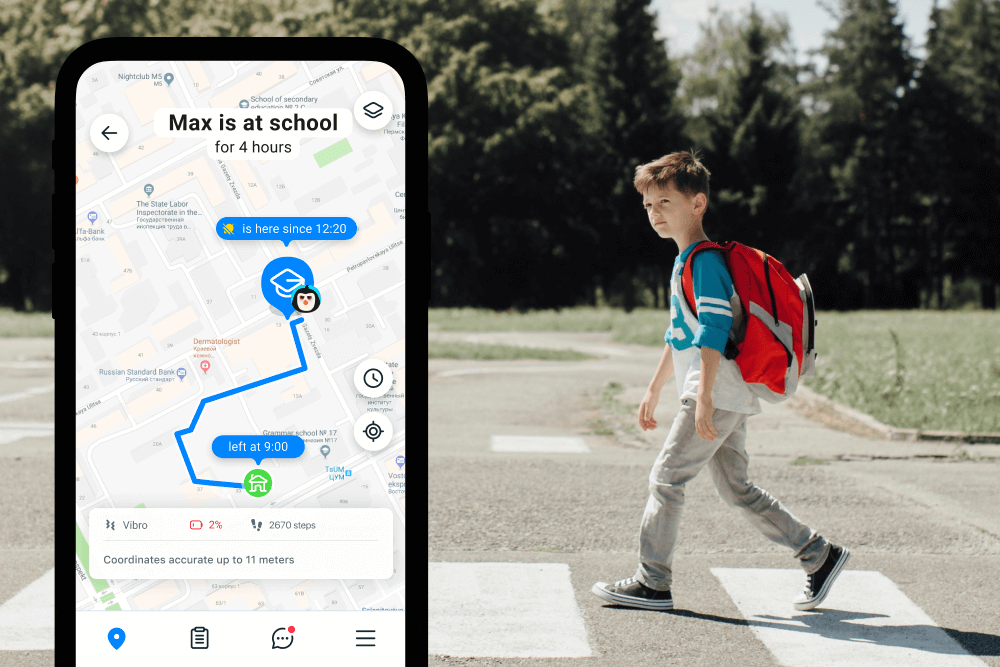
Findmykids App
The Findmykids app offers various features that can assist in addressing bullying situations in schools. Here are some of the functions and how they can be helpful:
Real-time location tracking
The app allows parents and guardians to track their child’s location in real time, providing them with peace of mind and ensuring their safety. In bullying cases, this feature can help parents monitor their child’s movements and ensure they are not exposed to potential threats.
If a child is being bullied on their way to or from school, the real-time location tracking feature can help parents identify the specific areas where the bullying incidents occur and take appropriate action, such as informing school authorities or arranging alternative transportation.
Geofencing

Findmykids app
By setting up geofences, parents can define safe zones for their children, such as the school premises. If the child enters or leaves these designated areas, the app sends an instant notification to the parent, helping them stay informed about their child’s whereabouts and potential bullying incidents that may occur outside the safe zones.
Geofencing can be utilized to ensure that the child remains within the school premises during school hours, minimizing the chances of bullying incidents happening outside the designated safe zones.
SOS button
The app includes an SOS button that the child can use in emergency situations.
If the child feels threatened or bullied, they can quickly press the SOS button, triggering an immediate alert to the parent’s device. This allows parents to take swift action and intervene in critical situations and stop bullying.
Voice monitoring

Findmykids app
The app enables voice monitoring, allowing parents to listen to their child’s surroundings discreetly. This feature can be useful in detecting instances of verbal bullying or identifying potentially unsafe situations.
In situations where verbal bullying is suspected, voice monitoring can provide valuable evidence to support the child’s claims and facilitate intervention by parents or school officials.
By leveraging these features of the Findmykids app, parents can actively address bullying situations, protect their children, and take necessary steps to ensure their well-being and safety.
Ready to ensure your child’s safety and tackle bullying head-on? Download the Findmykids app now and empower yourself with powerful tools to protect your child. Take control and create a safer environment today!
How to Deal With Bullying at School?

fizkes/Shutterstock.com
What If the Child is a Victim?
Here is some advice:
- If you are being bullied at school this could take the form of, for example, name-calling, having your clothes spoiled, your things taken from you, or aggression. It’s vital to speak about what’s happening to a parent, teacher, or another trusted adult friend or family member. Remember that asking for help is not a sign of weakness, but a good mature solution to the problem.
- Don‘t be afraid that things will get worse if you tell someone about the bullying or make a bullying report. Being supported and protected is the most important thing to help resolve the situation.
- If you are being bullied on the Internet, keep all messages, voice messages, videos, and photos as proof of what’s been happening.
- Don’t feel bad about what’s happening, or as if you are weak—anyone can be the victim of bullying, even adults.
How Parents Should Behave?
If your child is being bullied at school, remember the following:
The first and main point–help your child to deal with any feelings of guilt or shame!
Explain that it is not his or her fault and that the bullying is no reflection on them. Bullying happens, and although the situation is awful, it can be resolved.
- Let the child know that you are on his or her side. Support them and help them to stay calm: ‘That is so good that you have told me everything! I believe in you. You are not to blame. I will help you to move on’.
- Talk to the child about the situation. Explain to him or her some steps to take next.
- Help develop your child’s confidence and boost their self-esteem. Teach them the right ways to stand up and speak out when they witness harassment at school—or other ways to handle this, such as telling a teacher what has happened.
- Have a talk with the headteacher, other teachers, or school superintendent and the aggressor‘s parents.
If the situation is serious and you cannot resolve it peacefully, you may wish to move your child into a new class or even school. This is an extreme measure, not least because you cannot be sure that the same situation will not happen again in a new school.
Regarding cyberbullying: if the bully is known to you, block this person, so they cannot continue to message your child via the social network or platform. You could also report the perpetrator to the administration of the site. If the aggressor is anonymous, print out the messages, take screenshots, download videos and photos, and contact your local police office if necessary.
A key part of parenthood is not only protecting your child but also teaching him or her how to communicate with people around them in the correct way. It can be really hard to avoid violence and aggression in our everyday life. A kid must know how to say ‘no’, not to succumb to the provocation of peers, and understand the importance of sharing problems with adults, so that they can help to solve them. Make sure your child is aware that bullying is something that they never have to suffer through alone—you’ll always have their back and will support them.
How to Prevent Bullying in Schools?

Prostock-studio/Shutterstock.com
Prevention is better than cure, and school bullying is no exception. Parents and teachers need to do everything within their power to prevent aggression, violence, and other forms of bullying taking place.
Dear teachers! Be always mindful of aggressive behavior taking place in the classroom, even if it’s subtle. Any hint of bullying should be looked into. It’s vital to pay attention to the formation of a community of children in the class and the identification of ‘outcasts’ and ‘black sheep’. Also, be aware of your student’s activities on the Internet and pay attention to the posts and comments. That is not a call for the violation of student’s privacy, but it may help to prevent violence and to protect your students. You could organize team-building events, trips, tours, and visits. Involve a school psychologist and a counselor, if you think (or have been advised) that bullying is occurring—cooperate with families, and be sensitive to their needs.
Here’s a run-down of some of the steps teachers can take to keep bullying out of the classroom:
- Identify the problem
- Develop anti-bullying protocols that are easy for kids to understand and follow
- Create a safe environment and positive school climate in the classroom in which all children feel included and heard
- Consider the profile of a bully
- Be mindful of the signs of bullying
- Implement bullying protection programs
- Focus on social-emotional learning opportunities
- Engage parents
- Organize workshops on tackling and preventing bullying
- Consider ways to help prevent bullying outside of school
Dear parents! Tell your children about bullying and how they can protect against it. Explain to them that speaking about any bullying that’s occurring is the best, most mature solution, and not an act of weakness.
Children! During your life, you will encounter unfairness, meanness, and aggression. Try to be stronger than the bullies, learn to say ‘no’, when somebody encourages you to do something bad, and confront the bully. Find friends who share your values, and hang out only with the people who respect and appreciate you.
Bullying can have terrible consequences for everyone involved—most significantly, of course, the victim. However, as parents and school staff, we have the opportunity to teach and support our kids to help prevent them from suffering bullying—or becoming the bully themselves. Remain mindful and watch out for any indication of bullying—never ignore these warning signs. Most of all, ensure your child always feels supported, loved, and heard, to provide them with the best defense against potential bullying.
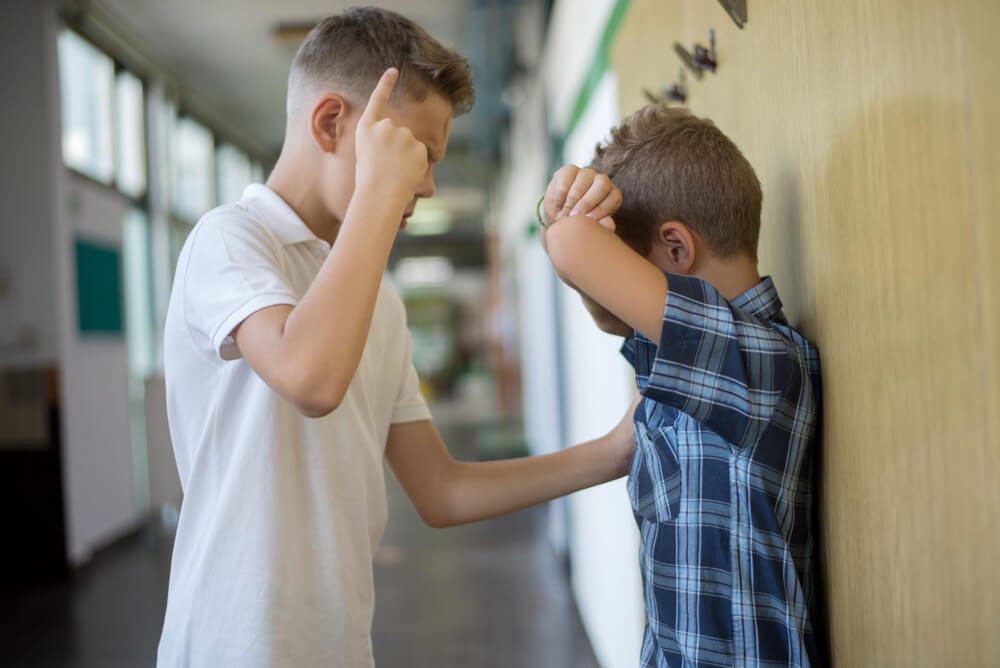
Savicic/Shutterstock.com
FAQ
Are schools effective in stopping bullying?
While bullying commonly takes places within the school environment, schools are uniquely positioned to effectively stop bullying it from happening. Success in this regard will largely depend on the overarching attitude and culture of the school, and the mindfulness of teachers to the problem. Engaging parents in the process of tackling bullying is also vital.
What are the three Rs of bullying prevention?
For those working in schools, the three Rs are Recognize, Respond, and Report.
What is a no-bullying policy in schools?
This may take many different forms, depending on the school. In general, a school anti-bullying policy should clearly lay out a definition of bullying, how bullying will be prevented, and also include how incidents of bullying will be responded to.
What is the effect of bullying on academic performance?
Bullying can have a significant negative impact on academic performance. A recently commissioned report discovered that children who suffered chronic levels of bullying during their school years manifested not only lower academic achievement, but were less confident in their academic abilities than their peers.
The picture on the front page: Rawpixel.com/Shutterstock.com
Проверьте электронный ящик















